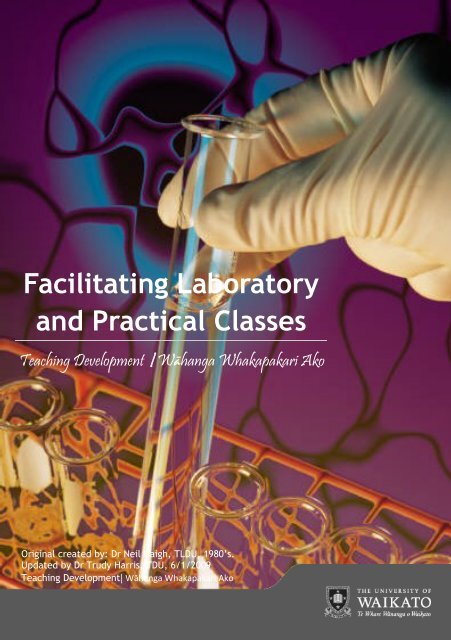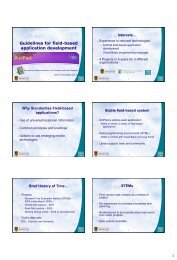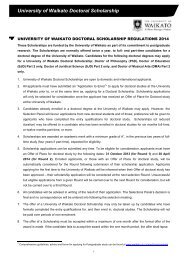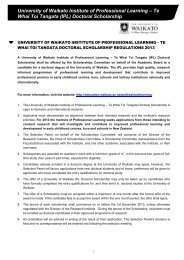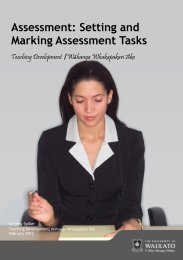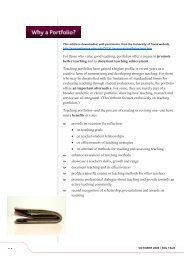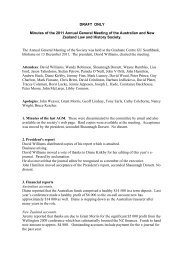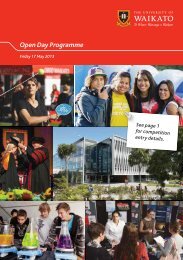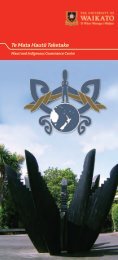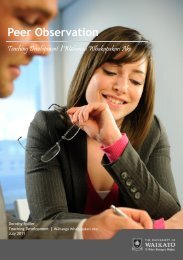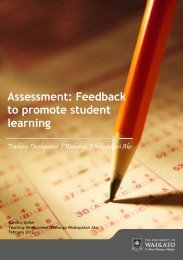Facilitating Laboratory and Practical Classes - The University of ...
Facilitating Laboratory and Practical Classes - The University of ...
Facilitating Laboratory and Practical Classes - The University of ...
You also want an ePaper? Increase the reach of your titles
YUMPU automatically turns print PDFs into web optimized ePapers that Google loves.
So while this laboratory deals with some <strong>of</strong> theessential knowledge it should also help to developsome <strong>of</strong> the essential skills. Ideally the laboratorylearning experience should combine both <strong>of</strong> theseobjectives. While research <strong>of</strong> this nature is a bitexcessive for running one laboratory, manypr<strong>of</strong>essional institutions <strong>and</strong> external agenciesprovide information about what they regard asessential knowledge <strong>and</strong> skills for graduates.2. Teaching strategies for laboratories <strong>and</strong>practical classes<strong>The</strong> next step is to develop teaching strategiesthat enable students to achieve the aims <strong>and</strong>objectives that you have outlined for thelaboratory or practical class. Three main teachingstrategies are generally used:Controlled sessions<strong>The</strong>se are activities devised by staff <strong>and</strong>completed by the students in one or twolaboratory sessions. This strategy is well suited tothe development <strong>of</strong> specified key skills wherepractice can lead to a high degree <strong>of</strong> competence.This strategy usually comprises: <strong>The</strong> teacher or demonstrator introducing theactivity <strong>The</strong> students carrying out the experimentfollowing a written procedure <strong>The</strong> students writing <strong>and</strong> submitting a reportfor assessment.It is easy to find examples <strong>of</strong> controlled sessionsin journals <strong>and</strong> other sources but using them canbe problematic as the examples might not give a• 7 •FACILITATING LABORATORY & PRACTICAL CLASSES • TDU
Research projects<strong>The</strong>se are problems that are studied over a longerperiod <strong>of</strong> time. Generally this form <strong>of</strong> teachingstrategy incorporates elements <strong>of</strong> the previoustwo. <strong>The</strong> intention here is to simulate moreclosely real-life research <strong>and</strong> developmentactivities that students might encounter in theirpr<strong>of</strong>essional life. This teaching strategy can takethe form <strong>of</strong> a small project exercise over asemester, or a longer research project whichmight allow a student to become part <strong>of</strong> aresearch group. Whichever approach is used, thestudent has to take ownership <strong>of</strong> the researchproject, <strong>and</strong> along with a supervisor explorevarious scientific approaches <strong>and</strong> analyses.While this teaching strategy is extremelyimportant especially for Postgraduate students, itis outside the scope <strong>of</strong> this booklet.(Adopted from Boud, Dunn et al., 1986)3. <strong>The</strong> ingredients <strong>of</strong> the activityOnce an appropriate teaching strategy has beenchosen, a detailed activity needs to be designed.While the underlying principles to bedemonstrated are dependent on the discipline, thegeneral steps required to develop an activity toshow these principles are consistent acrossdisciplines. Rowntree (1981) developed a simpleframework which can aid in the development <strong>of</strong> atask based activity:1. What is the task?2. When should the task be carried out?3. What tools, equipment, <strong>and</strong> materials areneeded?• 9 •FACILITATING LABORATORY & PRACTICAL CLASSES • TDU
efore the laboratory takes place, or the use <strong>of</strong>media, such as a video, dvd, audio tapes or evenComputer Aided Learning packages which set outthe main themes <strong>and</strong> underlying principles <strong>of</strong> aparticular task. If you have identified new ideas/words etc, now would be a good time to introducethem to the students.► Post-laboratory activitiesThis is mainly confined to the written report thatis h<strong>and</strong>ed in after the lab has been completed.While this gives a permanent record <strong>of</strong> what hasbeen done, <strong>and</strong> can be completed in a verymechanical way by students, the report does notnecessarily give an indication <strong>of</strong> a student‟spractical skill in a laboratory. An alternative is touse small group discussions/presentations orinterviews to identify what learning has takenplace during the laboratory or practical class.However, interviewing large numbers <strong>of</strong> studentscan be time consuming, but this could beundertaken by demonstrators rather than theteacher/convener.Section B. Teaching in a laboratory orpractical classOnce the activity has been determined <strong>and</strong> brokendown, <strong>and</strong> you are sure that it can easily becompleted within the prescribed timeframe, thenext thing to consider is how the laboratory/practical class will be staffed?FACILITATING LABORATORY & PRACTICAL CLASSES • TDU• 14 •
1. So who facilitates what in the laboratoryor practical class?With the ever exp<strong>and</strong>ing pressures on academictime is it prudent for the teacher, to spend a greatdeal <strong>of</strong> time in the laboratory or practical class?THE TEACHER<strong>The</strong>re are a number <strong>of</strong> different staffing strategiesthat can be used, depending on the time that theteacher has to spend in the class.► Teacher as demonstratorIf the teacher has the luxury <strong>of</strong> being able tospend three hours in the laboratory with a smallclass then there will probably be littlerequirement for further staffing. Here the teacherwill be able to demonstrate the activity centrally<strong>and</strong> continually move amongst the studentsensuring that a sufficient level <strong>of</strong> knowledge/skillhas been gained. Additionally, if the teacher hadalso given the relevant lectures, he/she can makeregular links to theory. In this scenario thestudent/ teacher contact is at a maximum.► Teacher <strong>and</strong> demonstratorsHowever, in most cases the inevitable increase instudent numbers <strong>and</strong> the concurrent decrease inexpensive laboratory space generally lead to largeclasses in cramped conditions. Here, although theteacher can still demonstrate or explain theactivity centrally, there will not be enough time tosee all students. It is therefore necessary to ensurethat there are sufficient demonstrators who arecompetent in this particular field, who can mingle• 15 •FACILITATING LABORATORY & PRACTICAL CLASSES • TDU
2. What teaching skills will be required?Both teachers <strong>and</strong> demonstrators will be asked tocall on a large range <strong>of</strong> teaching skills during therunning <strong>of</strong> a laboratory or practical class. Some<strong>of</strong> these are briefly outlined below:PERFORMING<strong>The</strong> performing <strong>of</strong> an activity for students toobserve is the defining feature <strong>of</strong> this way <strong>of</strong>teaching. In some cases it may be the teacherdoing the „performance‟ or a demonstrator.Generally the performance is live with alternatingdescriptions. <strong>The</strong> flexibility <strong>of</strong> this approachmeans that questions can be asked <strong>and</strong> answeredimmediately. However if the class is very large oris part <strong>of</strong> a distance learning course thenperformances can be shown on video or DVD.DESCRIBING<strong>The</strong> teacher generally describes the importantaspects <strong>of</strong> the activity. It is important todetermine how much description you require.This should be based on the current level <strong>of</strong> theknowledge/skills base <strong>of</strong> your audience, <strong>and</strong> theskills that you want the students to be capable <strong>of</strong>when they finish the activity. It is a good idea toscript some aspects <strong>of</strong> the description so that youcan remember all the salient facts at specificpoints in your performance. Generally breakingup descriptions into small chunks helps to makethe learning more accessible for students.EXPLAININGExplanations are essential if students are going tounderst<strong>and</strong> how the activity fits within the• 17 •FACILITATING LABORATORY & PRACTICAL CLASSES • TDU
ARTICLE 6FIRE CAPTAINSection 1 – AuthorityA. Shall under the general direction <strong>of</strong> a Battalion Chief be the supervisor <strong>of</strong> a fire companywithin the operations division. During the absence <strong>of</strong> the Battalion Chief, he/she shallwhen assigned, assume the duties, responsibility <strong>and</strong> authority <strong>of</strong> the Battalion Chief.Section 2 – Duties <strong>and</strong> ResponsibilitiesA. General1. Shall be responsible for the conduct <strong>and</strong> efficiency <strong>of</strong> the members under theircomm<strong>and</strong>, record keeping, computer data entry, the cleanliness <strong>of</strong> the station, allstation apparatus, supplies <strong>and</strong> equipment assigned to the station. Where morethan one company <strong>of</strong>ficer is assigned to a station, they all shall be responsible forthe same.2. Shall under the direction <strong>of</strong> his/her Battalion Chief <strong>and</strong> during assigned shifts,have full charge <strong>of</strong> <strong>and</strong> be responsible for the firefighting operations <strong>and</strong> for thecare, operation <strong>and</strong> condition <strong>of</strong> their assigned fire station, its personnel <strong>and</strong>equipment.3. Shall apportion station duties among members <strong>and</strong> equalize the assignments asfairly as possible.4. Shall have considerable knowledge <strong>of</strong> the geography <strong>of</strong> assigned district,including location <strong>of</strong> streets, hydrants, railroad crossings, <strong>and</strong> all appropriatehigh-rise <strong>and</strong> target hazard structures.5. Shall have a thorough knowledge <strong>of</strong>, <strong>and</strong> shall ensure that members under theircomm<strong>and</strong> are familiar with <strong>and</strong> adhere to, the following:• Rules <strong>and</strong> Regulations• Policies <strong>and</strong> Procedures• SOGs <strong>of</strong> the Little Rock Fire Department• Civil Service Rules <strong>and</strong> Regulations <strong>of</strong> the City <strong>of</strong> Little Rock• Memor<strong>and</strong>um <strong>of</strong> Underst<strong>and</strong>ing• Administrative Personnel Policy <strong>and</strong> Procedural Manual6. Shall be able to train <strong>and</strong> instruct firefighters in firefighting principles, practices<strong>and</strong> procedures <strong>and</strong> evaluate subordinate performance.September 2009 - 12 -
2. Getting underway Arrive at the class early. This will allow you tomake contact with, <strong>and</strong> build up a relationshipwith the students in the class. Students aremore likely to ask for help from someone whois genuinely interested in them. It also helps if you take the time to learn thestudents‟ names. It shows that you areinterested. Take time at the beginning <strong>of</strong> thesession to introduce yourself, but alsoremember to introduce the other members <strong>of</strong>your teaching team. Always provide a calm exterior even if insideyou are experiencing impatience. Generally try <strong>and</strong> be yourself <strong>and</strong> avoidputting on an act.If you are providing the introduction to thelaboratory or practical class, make sure you havedone enough preparation to allow you to getunderway confidently<strong>and</strong> competently.3. Doing the roundsOnce the laboratory orpractical class isunderway, thedemonstrators can startto move amongst thegroups <strong>of</strong> students. Thispart <strong>of</strong> the laboratoryprocess is where themain trouble-shooting<strong>and</strong> development <strong>of</strong>students‟ criticalthinking occurs.FACILITATING LABORATORY & PRACTICAL CLASSES • TDU• 22 •
iv. Hanging around<strong>The</strong> demonstrator moves round the class in ar<strong>and</strong>om manner anticipating that students willrequest assistance as he/she moves by. Thisstrategy will make it easier for students to signalyou quietly. However the r<strong>and</strong>omness <strong>of</strong> the routemeans that there is a chance that some studentswill be overlooked, or that the demonstrator willbe locked in one place.<strong>The</strong>re is no perfect strategy for doing this, but acombination <strong>of</strong> the above approaches will allowdemonstrators to become sensitive to theparticular environment <strong>of</strong> the laboratory orpractical class.Once the demonstrator has identified an „introuble student‟, he or she needs to find anappropriate response. How do the demonstratorsgive help to a student without doing the work forthem especially if the student is to be assessedformally? Also how can demonstrators get thestudents to help themselves in underst<strong>and</strong>ing theirproblem? It will always be a challenge to balancethe need to provide students with support <strong>and</strong>enable them to take responsibility for their ownlearning.HOW TO GIVE HELP AND PROMPT THINKING<strong>The</strong> first part is to diagnose the student‟sproblem. <strong>The</strong> student can be asked to:▪ Offer explanations <strong>of</strong> the difficulties they have▪ Recount what they have done▪ Attempt the activity again, <strong>and</strong> report what theynotice, think or perceive is happeningFACILITATING LABORATORY & PRACTICAL CLASSES • TDU• 24 •
▪ Call on you at the first hint <strong>of</strong> difficulty <strong>and</strong>expect you to lead them through the entireactivity.▪ Make it look as though they are doing well butare in fact experiencing difficulty.▪ Doubt the accuracy <strong>of</strong> the information you haveprovided <strong>and</strong> make the same request <strong>of</strong> anotherdemonstrator.Here are some strategies that might help:▪ Explain to students what your role is. Somestudents will not be aware <strong>of</strong> what ademonstrator is <strong>and</strong> what you can or can‟t do.▪ Provide private opportunities for students tomake contact with you <strong>and</strong> talk about theirconcerns.▪ Talk to your fellow demonstrators <strong>and</strong> shareexperiences so that a consistency in approach isestablished. However be aware that somestudents will relate better to some demonstratorsthan others.DEALING WITH YOUR OWN „DON‟T KNOWS‟<strong>The</strong>re will come a time when a student will ask aquestion to which you will not know the answer.How will you respond?You could try covering up that you don‟t know.This is not a sensible option because it can lead tomisunderst<strong>and</strong>ing. However a lot <strong>of</strong> teachers do itto avoid embarrassment.FACILITATING LABORATORY & PRACTICAL CLASSES • TDU• 26 •
Acknowledge that you don‟t know, <strong>and</strong> then tryone <strong>of</strong> the following:▪ Undertake to find an answer <strong>and</strong> report back tothe student. However this method means thatthe student does not have to help answering thequestion.▪ Prompt the student to find the answer to thequestion.▪ Invite other class/group members to try.▪ Suggest that you work together to find theanswer.<strong>The</strong> last three suggestions will also promptcritical thinking.4. Finishing upIdentify with the demonstrators what the studentsneed to have achieved to finish the laboratory orpractical class. Will the students be free to leaveonce they have achieved these goals?• 27 •FACILITATING LABORATORY & PRACTICAL CLASSES • TDU
ReferencesBoud, D. Dunn, J. <strong>and</strong> Hegarty-Hazel, E. (1986).Teaching in Laboratories. <strong>The</strong> Society forResearch into Higher Education & NFER-NELSON. <strong>University</strong> <strong>of</strong> Guildford: UK.Boud, D. Dunn, J. Kennedy, T. <strong>and</strong> Thorley, R.(1980). <strong>The</strong> aims <strong>of</strong> science laboratorycourses: a survey <strong>of</strong> students, graduates <strong>and</strong>practicing scientists. European Journal <strong>of</strong>Science Education. Volume 2, pp. 415-428.Gibbs, G <strong>and</strong> Habeshaw, T. (1989). Preparing toTeach. Technical <strong>and</strong> Educational ServicesLtd: UK.Gibbs, G. <strong>and</strong> Jaques, D. (1987). Labs <strong>and</strong><strong>Practical</strong>s. Oxford Polytechnic: EducationalMethods Unit: UK.Gibbs, G. Gregory, R. <strong>and</strong> Moore, I (1997). Labs<strong>and</strong> <strong>Practical</strong>s with more Students <strong>and</strong>Fewer Resources. <strong>The</strong> Oxford Centre forStaff Development: UK.Ed. Bailie, C. <strong>and</strong> Moore, I. (2004). EffectiveLearning <strong>and</strong> Teaching in Engineering.Routledge Farmer: UK.Ed. Moore, I. <strong>and</strong> Exley, K. (1999). Innovationsin Science Teaching 2. Staff <strong>and</strong>Educational Development Association(SEDA), Paper 107, UK.Rowntree, D. (1981). Developing courses forstudents. McGraw-Hill: UK.FACILITATING LABORATORY & PRACTICAL CLASSES • TDU• 28 •
Produced by:Teaching Development Unit | Wāhanga Whakapakari AkoPrivate Bag 3105Hamilton 3240 New Zeal<strong>and</strong>Phone: +64 7 838 4839Fax: +64 7 838 4573tduadmin@waikato.ac.nzwww.waikato.ac.nz/tdu


